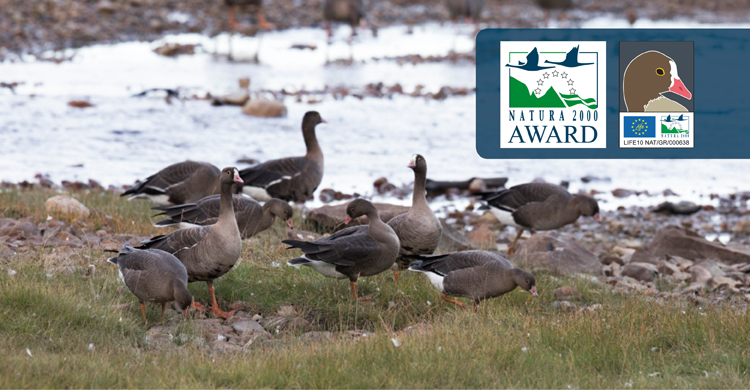EU LIFE+ Project for Globally Threatened Lesser White-fronted Goose Wins European Natura 2000 Award

Lesser White-fronted Geese (Anser erythropus) © Tomas Aarvak
Brussels/Bonn, 24 May 2016 – The EU LIFE+ project “Safeguarding the Lesser White-fronted Goose along its European Flyways” (LIFE10NAT/GR/638) is amongst this year’s winners of the European Natura 2000 Award, which were announced on 23 May in Brussels during an evening awards ceremony hosted by the European Commission. The project came first in the category “Cross-border cooperation and Networking”.
The Lesser White-fronted Goose (Anser erythropus) is globally threatened and the small Fennoscandian population which breeds in northern Norway and migrates to wintering grounds in Greece is teetering on the brink of extinction.
The focus of the current LIFE project has been to carry out and facilitate urgent, concrete conservation actions particularly in the wintering and staging grounds of the species in Bulgaria, Greece and Hungary as well as policy work, awareness-raising, vocational training and environmental education. These activities have been implemented through an extensive network of international, national and local experts and stakeholders throughout the Eurasian migration routes of the population. Within the EU, project actions are being implemented at seven Natura 2000 sites.
What makes this project really unique is the multi-level dimension of the network it has helped to establish. Not only does the network cover the flyway of the populations both within the EU and beyond, it also cuts across different levels of society: from high level government officials, to field practitioners and school children. An estimated 1,500 people have been connected in some form through the project to date.
A key achievement has also been the significant contribution of the project to the overall development and implementation of international conservation measures and standards for the species within the framework of the inter-governmental AEWA Lesser White-fronted Goose International Working Group.
The actions being implemented are also slowly yielding concrete results: when the project started in 2011, the Fennoscandian Lesser White-fronted Goose population numbered between 50-70 individuals - now, the population has grown to some 110 birds, leading to record-breaking numbers observed at key sites across the flyway. The network is thus very much looking forward to continuing the good work for the species in the years to come.
“This project is a great example of how coordinated international conservation action across a particular flyway can really make a difference - not only for the target species itself, but also because it brings people together and benefits habitats as well as other birds.”
Jacques Trouvilliez, Executive Secretary of the African-Eurasian Migratory Waterbird Agreement (AEWA).
Coordinated by the Hellenic Ornithological Society (HOS/BirdLife Greece), the EU LIFE+ project team is a reflection of the network it has strived to establish, comprising four national public authorities (Ministry of Environment and Energy/Greece, the Forest Research Institute/Greece, Hortobágy National Park Directorate/Hungary and Metsähallitus/Finland), three NGOs (HOS/Greece, BSPB/Bulgaria, and WWF/Finland), as well as the UNEP/AEWA Secretariat. In addition to these partners, the project engaged a total of 15 countries along the species’ flyway and was supported in particular by the Norwegian Environment Agency as well as the Norwegian Ornithological Society (BirdLife Norway).
Natura 2000 works to ensure the long-term survival of Europe's most valuable and threatened species and habitats, and is the centrepiece of the EU's nature and biodiversity policy. The European Commission launched the Natura 2000 Award to celebrate and promote best practices for nature conservation in Europe. The Award also aims to bring the success of the Natura 2000 network to the public’s attention and to demonstrate its importance for protecting biodiversity across Europe.
For more information, please contact AEWA Associate Programme Officer Ms. Nina Mikander.
Produced by HOS/BirdLife Greece within the framework of the EU LIFE project
Last updated on 17 June 2016


